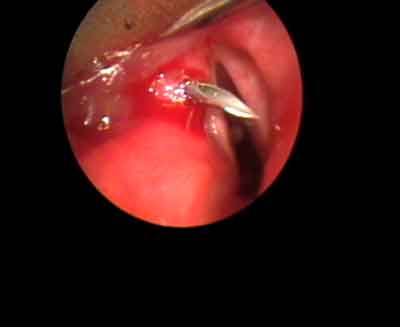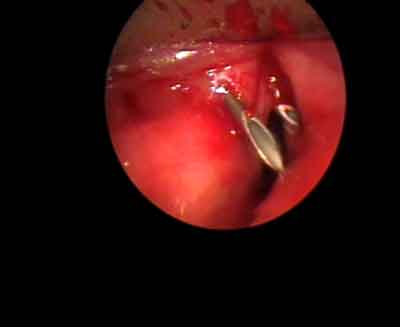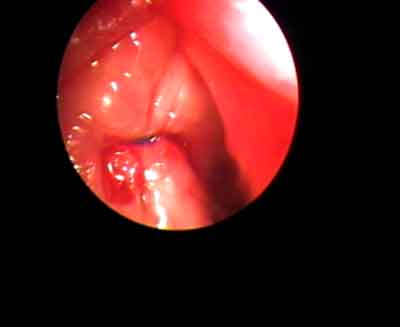© Borgis - New Medicine 3/2008, s. 70-72
*Lidia Zawadzka-Głos
SURGICAL TREATMENT OF BILATERAL VOCAL CORD PARALYSIS IN CHILDREN
Department of Paediatric Otorhinolaryngology, Medical University of Warsaw
Head of Department: Prof Mieczysław Chmielik, MD, PhD
Summary
Aim: Unilateral or bilateral paralysis of the vocal cord is the second most common cause of stridor in neonates after laryngomalacia. Symptoms may be present at or shortly after birth, or they may be delayed in onset. The symptoms of unilateral paralysis include a hoarse cry and stridor on deep inspiration. Children with unilateral vocal cord paralysis will most commonly recover spontaneously or compensate. Children with bilateral paralysis will manifest upper airway problems. Symptoms vary from total obstruction to slight problems with exercise tolerance. If the obstruction of the airway is severe the patients will require tracheotomy. Failure of recovery of normal motion and function or failure of development of complete compensation with persistence of symptoms may necessitate surgical treatment of laryngeal paralysis.
Material and methods: In the Department of Paediatric ENT in Warsaw, between 1998 and 2008, 58 children with dyspnoea and voice disorders were admitted. Six patients aged from 1 to 14 years underwent lateral fixation of the vocal cord.
Results: We performed lateral fixation of vocal cords in 6 cases with good results.
Conclusions: Lateral fixation of the vocal cords is a safe and effective endoscopic technique. The procedure is easy to perform satisfactorily in children´s larynges.
INTRODUCTION
Vocal cord paralysis is a frequent problem in children. It may cause the patient little or no difficulty, or it can be life-threatening. Vocal cord paralysis presents a variety of symptoms. Successful management of vocal cord paralysis depends upon accurate diagnosis and methods to treat the specific disorders.
The position of the vocal cords usually correlates with the symptoms.
Paralysis of the vocal cords may be bilateral or unilateral and complete or partial. The recurrent laryngeal nerve and vagus nerve may be paralyzed because of disease or injury anywhere along its course from the brain stem to the larynx. The left vocal cord is the more commonly paralyzed of the two, probably because its course is longer and more vulnerable than that of the right. There are a lot of causes of vocal cord paralysis: neck trauma, mediastinal and thoracic surgery, cardiovascular pathology, neurofibroma of parapharyngeal space, lymphoma, central nervous dysfunction, severe head injury, Arnold-Chiari malformation, multiple congenital anomalies, toxic and metabolic causes, inflammation and tumours of the larynx (1, 2, 5).
Children with unilateral vocal cord paralysis will most commonly recover spontaneously or compensate. In either situation, no intervention will be required. Most surgeons agree that recovery will take place within six months to a year of onset. In most patients who do not recover recurrent nerve function, the contralateral vocal fold will compensate by moving across the midline to achieve satisfactory glottic closure (6, 7, 9).
Children with bilateral paralysis will manifest upper airway problems. Symptoms vary from total obstruction to slight problems with exercise tolerance. If the obstruction of the airway is severe the patients will require tracheotomy. Once the airway is stabilized, consideration can be given to further management of bilateral vocal cord paralysis, if indicated. Complete paralysis can occur with injury to the vagus nerve above the point of departure of the superior laryngeal nerve. Dyspnoea occurs when the breathing surface of the glottis is decreased by 3/4 (4, 7, 10). Central paralysis can occur with various disorders such as perinatal asphyxia, Arnold-Chiari malformation, multiple congenital anomalies of the central nervous system, Charcot-Marie-Tooth syndrome, Guillain-Barre syndrome, cerebral vascular haemorrhage and others (2, 3, 5, 8). Peripheral paralysis can be caused by the following: mediastinal and thoracic surgery, neck surgery, neck trauma, toxic and metabolic causes, inflammatory factors.
Because of the correlation with other pathologies, children with vocal cord paralysis should be investigated for intrathoracic and intracranial pathology.
There are some surgical interventions for vocal cord paralysis. Various surgical procedures have been employed to fix the arytenoid cartilage laterally in an attempt to gain an adequate airway but again at the expense of good voice. The first arytenoidectomy was performed by Kelly in 1941, through a window in the thyroid cartilage. In 1946 Woodman used a lateral laryngeal approach to perform an arytenoidectomy. Thornell described translaryngeal arytenoidectomy by submucous resection of the arytenoid cartilage. In 1968 Downey and Keenan suggested laryngofissure as an approach through which arytenoidectomy could be performed. In arytenoidectomy in children, cordectomy or submucous resection of the vocal cord is performed rarely.
AIM
The aim of surgery for permanent bilateral vocal cord palsy is to produce an airway of sufficient size to allow decannulation, without compromising the protective function of the larynx or producing unacceptable voice quality.
MATERIAL and method
In the Department of Paediatric ENT in Warsaw, between 1998 and 2008, 58 children with dyspnoea and voice disorders were admitted. There were 16 children with bilateral vocal cord paralysis. Six patients aged from 1 to 14 years underwent lateral fixation of the vocal cord.
The straight needle is introduced percutaneously through one side of the thyroid cartilage immediately under the vocal cord so that the tip of the needle can be seen in the lumen of the larynx. A similar needle is introduced through the thyroid cartilage above the first one. The tip of the second needle protrudes into the larynx. The 3-0 nylon suture is passed through the needle and then the vocal cord is fixed laterally (fig. 1, fig. 2, fig. 3).

Fig. 1. The needle above the vocal cord.

Fig. 2. The needle under and above the vocal cord.

Fig. 3. Lateral fixation of the vocal cord.
RESULTS
There were 23 girls and 35 boys with ages varying from 9 days to 15 years. In 19 cases congenital abnormalities and diseases of the central nervous system were found. In 27 cases congenital defects of the cardiovascular system were found in the past, or cardiosurgical intervention had been performed. In 5 children neck trauma had occurred and in 7 cases we could not establish the aetiology of the vocal cord paralysis. Various surgical techniques have been described to tract vocal cords in children. In the Department of Paediatric ENT in Warsaw we use a lateralization technique. We performed lateral fixation of vocal cords in 6 cases with good results. There were no immediate complications. Among six patients two were decannulated, in one without tracheostomy the respiratory symptoms disappeared, and the others are waiting for decannulation.
CONCLUSIONS
Lateral fixation of vocal cords is a safe and effective endoscopic technique. The procedure is easy to perform satisfactorily in larynges of children.
Piśmiennictwo
1. Altman KW, Wetmore RF, Marsh RR.: Congenital airway abnormalities requiring tracheotomy: a profile of 56 patients and their diagnoses over a 9 year period. Int J Pediatr Otorhinolaryngol 1997 Aug 20; 41 (2); 199-206. 2. Berkowitz RG, et al.: Chromosomal abnormalities in idiopathic congenital bilateral vocal cord paralysis. Ann Otol Rhinol Laryngol 2001 Jul; 110 (7Pt1); 624-6. 3. Ballenger JJ.: Diseases of the Nose, Throat, Ear, Head and Neck . Lea & Febiger 1985. 4. Chmielik L, et al.: Vocal fold paralysis and paresis in children in ENT Clinic records. New Medicine 2/2003 (11), vol. 6, 12-15. 5. Cotton RT, Myer CM.: Practical Pediatric Otolaryngology. Lippincot-Raven,Philadelphia 1999. 6. Daya H, et al.: Pediatric vocal fold paralysis: a long-term retrospective study. Arch Otolaryngol Head Neck Surg 2000 Jan; 126 (1) 21-5. 7. Glimer W, et al: Vocal cord position in laryngeal paralysis. Arch Otolar. 1970; 91,575. 8. Jazbi B.: Pediatric Otorhinolaryngology. Appleton-Century-Crofts New York 1980. 9. Parikh SR.: Pediatric unilateral vocal fold immobility. Otolaryngol Clin North Am 2004 Feb; 37 (1): 203-15. 10. Zawadzka-Głos L, et al.: Analysis of indications for bronchoscopy in the Department of Paediatric Otolaryngology in Warsaw from 1999 to 2003. New Medicine 2/2003 (11), vol. 6, 4-12.


